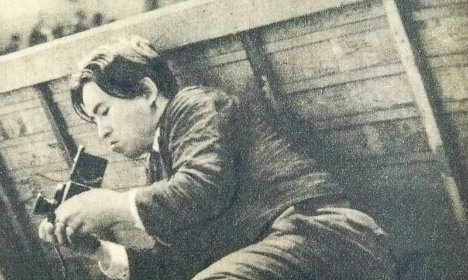Domon, who died in 1990, is venerated in Japan as one of the country's greatest photographers and a pioneer of realism, but relatively unknown internationally.
Organisers of the collection on display at the Italian capital's Ara Pacis museum hope that will begin to change with an exhibition that runs until September 18th.
It features some 150 of his works dating from the 1920s to the 1970s and encompasses the full range of his enormous output, from propaganda-style shots of military cadets and nurses destined for the frontline in the 1930s through his documenting of Japan's post-war social and political struggles.
There are also examples of his meticulous capturing of the country's temples and Buddhist statues and portraits of artistic figures of the 1960s and 1970s.
“He loved 'his' Japan, all of its art and its people and he wanted to show this Japan to the world through a Japanese eye,” said Takeshi Fujimori, a former student of Domon's who was in Rome for the opening.
Fujimori jointly curated the Rome exhibition with Rossella Menegazza, an Italian expert on the history of East Asian art.
Now the artistic director of the Ken Domon Museum of Photography in Sakata in northern Japan, Fujimori recalls Domon as having a gruff, uncompromising side to him that made him a hard taskmaster.
“That is why they called him the devil of photography. He never used words to teach, you had to learn by observing him.
Hiroshima turning point
“We were always afraid of making a mistake, knowing it could lead to a wallop on the back or a clout round the head.”
Another former student, Ushio Kido, described his former master as “a very sensitive person.”
“He loved human beings, especially children,” Kido said.
Children feature in many of the most striking images on display, from the small boy peeing in the street from a 1952-54 series to the laughing toddler who features alongside his equally joyous but disfigured father in “the Otani family” from his Hiroshima collection.
A small selection of the 7,800 images Domon took in and around Hiroshima in the Fall of 1957 form the heart of the collection in Rome and have been symbolically placed in a low-lit room in the centre of the riverside museum.
Twelve years after the first military use of the atomic bomb, the scars were still evident on the city's infrastructure and in the disfigured and reconstructed limbs and faces that Domon was to be severely criticised for recording, often weeping as he did so, according to his own account.
“People said it was too shocking, and he was attacked for capturing the reality of the survivors' situation,” said Menegazza.
“But for him it was a moment of change in his life. He recorded in his notebook the exact time at which he arrived in Hiroshima for the first time and for him him it was one from which there was no turning back.
“He realised that up until that moment he had chosen to ignore or had been afraid of what Hiroshima meant. And that pushed him deeper into realism.”



 Please whitelist us to continue reading.
Please whitelist us to continue reading.
Member comments